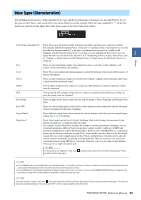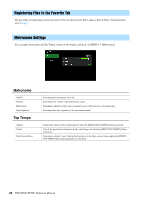Yamaha PSR-SX700 PSR-SX900/PSR-SX700 Reference Manual - Page 35
Voice Types (Characteristics
 |
View all Yamaha PSR-SX700 manuals
Add to My Manuals
Save this manual to your list of manuals |
Page 35 highlights
Voice Types (Characteristics) The defining characteristics of the particular Voice type and their performance advantages are described below. To see the type of each Voice, refer to the Voice List in the Data List on the website. Only the types marked by "*" in the list below are indicated at the upper left of the Voice name in the Voice Selection display. Voices S.Art (Super Articulation)* These Voices provide many benefits with great playability and expressive control in real time. For example, with the Saxophone Voice, if you play a C and then a D in a very legato way, you will hear the note change seamlessly, as though a saxophone player played it in a single breath. Similarly with the Concert Guitar Voice, if you play a C note and then the E just above in a very 2 legato but firm way, the pitch slides up from C to E. Depending on how you play, other effects such as "shaking" or breath noises (for the Trumpet Voice), or finger noises (for the Guitar Voice) are produced. Live These acoustic instrument sounds were sampled in stereo, to produce a truly authentic, rich sound-full of atmosphere and ambience. Cool These Voices use sophisticated programming to capture the dynamic textures and subtle nuances of electric instruments. Sweet These acoustic instrument sounds also benefit from Yamaha's sophisticated technology, and feature a finely detailed and natural sound. Drums Various drum and percussion sounds are assigned to individual keys, letting you play the sounds from the keyboard. SFX Various special effect sounds and percussion sounds are assigned to individual keys, letting you play the sounds from the keyboard. Live Drums These are high-quality drum sounds that take full advantage of Stereo Sampling and Dynamic Sampling. Live SFX These are various high-quality special effect sounds and percussion sounds that take full advantage of Stereo Sampling and Dynamic Sampling. Organ Flutes* These authentic organ Voices let you adjust the various footages and craft your own original organ sounds. See page 50 for details. MegaVoice* These Voices make special use of velocity switching. Each velocity range (the measure of your playing strength) has a completely different sound. For example, a guitar MegaVoice includes the sounds of various performance techniques. In conventional instruments, different Voices having those sounds would be called up via MIDI and played in combination to achieve the desired effect. However, now with MegaVoices, a convincing guitar part can be played with just a single Voice, using specific velocity values to play the desired sounds. Because of the complex nature of these Voices and the precise velocities need to play the sounds, they're not intended for playing from the keyboard. They are, however, very useful and convenient when creating MIDI data-especially when you want to avoid using several different Voices just for a single instrument part. NOTE To find and call up the "MegaVoice" folder, touch selected), and then select page 2. (Up) at the bottom right of the Voice Selection display (when Preset is NOTE • S.Art and MegaVoices are not compatible with other instrument models. For this reason, any Song or Style you've created on this instrument using these Voices will not sound properly when played back on the instruments which do not have these types of Voices. • S.Art and MegaVoices sound differently depending on keyboard range, velocity, touch, etc. Hence, if you turn on the [HARMONY/ARPEGGIO] button, change the trans- pose setting or change the Voice Edit parameters, unexpected or undesired sounds may result. NOTE To find and call up the "Legacy" folder, touch (Up) at the bottom right of the Voice Selection display (when Preset is selected), and then select page 2. This folder contains previous Yamaha keyboards' Voices (such as the PSR-S series) for data compatibility with other models. PSR-SX900/SX700 Reference Manual 35















